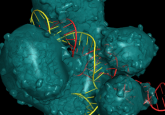Getting to the root of drought-resistant wheat

Scientists identify genes affecting root length that could make it easier to breed drought-resistant wheat.
Wheat is a key crop for ensuring global food security, but drought associated with climate change has impacted yields. In a recently published paper, an international group of researchers led by the University of California, Davis (CA, USA) identified a group of genes that can decrease the length of roots. Their results showed that reducing their dosage produces plants with longer roots. The scientists hope that these findings could lead to the breeding of better drought-resistant wheat crops.
While prior research has improved various qualities of wheat crops, some of these gains have been negated by crop loss due to water stress. With global warming, developing drought-resistant wheat that has increased yields despite lower water levels is vital to feeding the growing population.
Plants with longer roots have access to deeper water sources, making them more drought resistant. In this paper, scientists demonstrated that opriii genes have a large impact on the structure of root systems and show, for the first time, that modifying their expression can tailor root systems.
The researchers focused on validating the function of four opriii genes that prior research suggested are important in root system growth in monocotyledons (grass). The genes affect steps in the production of Jasmonic acid, a plant hormone that promotes the growth of lateral roots and reduces the depth of the seminal root.
 Rewriting oxytocin’s love story using CRISPR
Rewriting oxytocin’s love story using CRISPR
The neurohormone traditionally labeled the ‘love hormone’ may have just lost that title following a study on attachment behaviors in prairie voles.
Using CRISPR-Cas9 gene editing, the team created a wheat line with lower opriii dosage than their control by eliminating duplicated genes in wheat plants with reduced root length. The researchers also created a transgenic wheat line with increased opriii expression and a wheat line with an inserted rye chromosome, which decreases opriii expression.
The researchers identified that wheat plants with a loss-of-function mutation in the opriii genes had longer seminal roots compared with the control. They found that the plants with transgenic over-expression of opriii had a shorter seminal root and an increased number of lateral roots. Contrastingly, wheat with a rye chromosome had longer roots. Their results also validated that this effect is mediated by Jasmonic acid as pharmacological suppression of the hormone removed the root length differences.
Knowing the specific genes that determine root architecture could enable researchers to identify crops with naturally longer root systems and breed them for low-water environments. First author Gilad Gabad (University of California, Davis) said, “This finding is a useful tool to engineer root systems to improve yield under drought conditions in wheat.”





